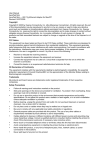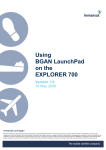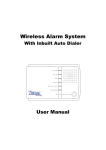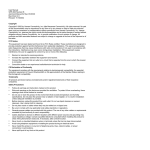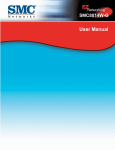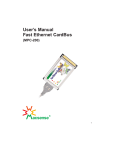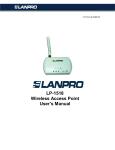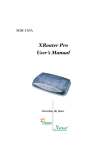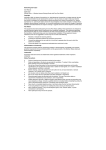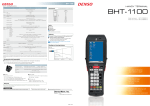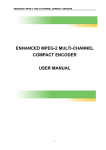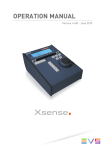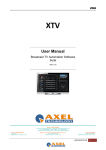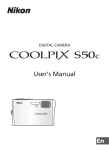Download AeroPad User Manual for Mac
Transcript
User Manual for Mac WUA-400 AeroPad Wireless USB Adapter Revised: 8/8/2002 Copyright Copyright © 2002 by Xsense Connectivity, Inc. (dba Macsense Connectivity). All rights reserved. No part of this documentation may be reproduced in any form or by any means or used to make any directive work (such as translation or transformation) without permission from Xsense Connectivity, Inc. Xsense Connectivity, Inc. reserves the right to revise this documentation and to make changes in content without obligation among Xsense Connectivity, Inc. to provide notification of such revision or change. All products and their associated features are subject to change or upgrade at the time of the shipment or of the sales. FCC Notice This equipment has been tested and found to be FCC Rules certified. These restrictions are designed to provide protection against harmful interference from residential installations. This equipment generates radio frequencies that may cause interference with radio communications if not used in accordance with the instructions. Interference may even occur during proper installation. If this equipment causes interference, the user is suggested to correct it by one or more of the following: • • • • Reorient or relocate the receiving antenna. Increase the separation between the equipment and receiver. Connect the equipment into an outlet on a circuit that is separate from the one to which the receiver is connected. Consult the dealer or an experienced radio/television technician for help. CE Declaration of Conformity The equipment complies with the requirements relating to electromagnetic compatibility, the essential protection requirement of Council Directive/EEC on the approximation of the Member States relating to Electromagnetic compatibility. Trademarks All products and brand names are trademarks and/or registered trademarks of their respective companies. Safety Precautions • • • • • • • • • • • • Follow all warnings and instructions marked on the product. Slots and openings on the device are provided for ventilation. To protect it from overheating, these openings must not be blocked or covered. Do not use or store this product in the environment that exceeds temperature and humidity specifications. Do not place this product near a radiator or heat register, or in a built-in installation unless adequate ventilation is provided. Before cleaning, unplug this product from wall outlet. Do not use liquid cleansers or aerosol cleansers. Use a damp cloth for cleaning. Do not place cords or cables where they may be walked on or tripped over. Be sure to comply with any applicable local safety standards or regulations. General-purpose cables are provided with this product. The use of any other cables or requirements mandated by local authority is user’s responsibility. Cables attached to devices in different locations with different power sources and grounding may cause hazardous voltage. Consult a qualified electronic consultant before installing the product to check if this phenomenon exists and, if necessary, take corrective action. Never touch un-insulated telephone wires or terminals unless the line has been disconnected. Avoid using telephone equipment or installing the product during an electrical storm. Never install this product, or any kind of telephone jacks, lines, network cables, or power connections in wet locations. Never spill liquid of any kind on this product TABLE OF CONTENTS 1.0 INTRODUCTION ........................................................................................ 3 1.1 Benefits ................................................................................................... 3 1.2 Features .................................................................................................. 3 1.3 Introduction to Wireless Networking ........................................................ 4 1.4 Wireless Network Planning ..................................................................... 5 2.0 BEFORE YOU START................................................................................ 7 2.1 Package Overview .................................................................................. 7 2.2 System and Other Requirements ............................................................ 7 3.0 MAC OS 9 SETUP...................................................................................... 9 3.1 Driver Installation..................................................................................... 9 3.2 Hardware Installation of AeroPad ............................................................ 9 3.3 TCP/IP Configuration............................................................................... 9 3.3.1 MacOS TCP/IP Configuration ....................................................... 9 3.3.2 Assigning TCP/IP Values Manually ............................................. 10 3.4 AppleTalk Configuration......................................................................... 11 3.5 Using the AeroPad Control Panel.......................................................... 12 3.5.1 Connecting with an Access Point ................................................ 12 3.5.2 Connecting with Peer-to-Peer ..................................................... 14 3.5.3 Encryption ................................................................................... 14 3.5.4 Information .................................................................................. 15 5.0 TROUBLESHOOTING ............................................................................. 17 5.1 Common Problems and Solutions ......................................................... 17 Consult the dealer or an experienced radio technician for help.5.2 Frequently Asked Questions ......................................................................................... 17 5.2 Frequently Asked Questions ................................................................. 18 5.3 Glossary ................................................................................................ 19 APPENDIX ..................................................................................................... 23 Specifications .............................................................................................. 23 1.0 INTRODUCTION Congratulations on purchasing the AeroPad, the Wireless LAN (WLAN) USB Adapter for Mac and PC. Welcome to the Macsense/Xsense Networking Product Family. These days, business moves at lightning speed. To compete, companies must make it easy for their employees to share vital business intelligence real-time and to collaborate without restriction. But until now, network users have been bound by the limits of their wired network, and forced to settle for access only where the network reached. A trend in the technology industry today is to eliminate the cable restrictions and hassle of wires by implementing a wireless network. By choosing wireless you reduce the hassle of cable clutter, the expensive need to run cabling in the home or office and the aggravation altogether to crawl under that desk for the last time to see if that Ethernet cable is connected. A WLAN standard called IEEE 802.11b has emerged delivering speeds of up to 11 Mbps and the ability to take the power of the Internet with you. Imagine the ease of which you can connect to your wireless network and to the Internet. Situate your computer in the most convenient location without regards to whether there is a switch or hub nearby. The AeroPad is a perfect solution when that Ethernet cable just isn’t long enough or you don’t want to settle for cables lying openly around the house. And for those older computers, such as the iMac, without a wireless solution, the AeroPad gives them the wireless capability they deserve. The convenience of where and when you want to connect to your network or Internet is now yours. 1.1 Benefits • Eliminates the hassle and cost of cabling. • Longer operating range gives you more room to move around. • Supports any desktop Mac, PowerBook with an USB port. • WEP encryption provides the highest security. • Compatible with Apple AirPort Base Station and all 802.11b-compliant access points. 1.2 Features • Interoperable with IEEE 802.11b (DSSS) 2.4GHz-compliant devices. • Up to 900 feet operating range in open environment. • High-speed data transfer rate of 11, 5.5, 2 and 1 Mbps • Auto-fallback to lower data rate in noisy environments. • WEP (Wired Equivalent Privacy) 40-bit and 128-bit data encryption for highest security. • Drivers support and Mac OS 9 and OS X (Available September 2002). 3 • Supports computer-to-computer (ad-hoc) connection without an access point. • Works with all standard Internet applications. 1.3 Introduction to Wireless Networking There are basically two types of wireless networks: Infrastructure and Ad-hoc. An Infrastructure network uses one or more access points (such as the XRouter Aero) as a gateway, linking the wireless network to a wired LAN. As a result, portable workstations on your wireless network have access to all the features of your wired LAN including email, Internet access, network printers and file servers. This is in contrast with another related wireless topology, called Ad-hoc network, in which each wireless workstation communicates with one another without the existence of an access point. 4 Although Ad-hoc allows for wireless connection between computers without an access point or Wireless Router, it is Infrastructure with its central wireless access point or Broadband Router that will be the most common. 1.4 Wireless Network Planning Although the arrival of affordable wireless technologies has provided a great deal of flexibility in how you connect to the Internet, there still is some needed planning in setting up a WLAN network. A WLAN can in some respects be considered much like a wired network with the exception that wireless adapters will transmit the data over radio frequency waves instead of within a shielded Ethernet cable. Because of this, the initial location of the access point or Wireless Router is extremely important. Situating the AeroPad so that it has the least amount of obstruction is highly advisable. The setup of all wireless devices involved is quite important, as they should share the same radio channel and ESSID. Without these common settings, they will not be able to communicate with one another. Any additional encryption settings for security measures must be configured identically on all devices to accept the data transfer. One of the greatest advantages is the adaptability of a wireless network. You can easily move a desktop computer within a room or to an entirely different room or floor without restrictions of an Ethernet cable. This, however, does take proper and precise planning of where to locate your access point(s) and how to overlap them so as to provide full wireless range. Some others points to follow when planning a wireless network: 1. 2. Minimize obstructions of the 802.11b RF waves a. Centrally locate the Wireless Router or access point. All obstructions will weaken the signal to some degree. b. Certain building materials (metals, concrete, etc.) should be avoided by the signal. Situate the wireless devices so as to maximize signal output and reception a. Situate the WLAN devices so the signal is going straight through the walls instead of at an angle. b. Stay clear (3 – 5ft.) of devices that introduce “noise” to the reception, such as microwaves, monitors, etc. c. Position the antenna to maximize RF signal output. d. Additional access points can be placed in areas of low or no signal reception. Note: The new 802.11b wireless protocol has limitations as to how far the wireless range can reach. Take your time to plan your wireless network properly to help provide the best range. Each obstruction can and will diminish the signal strength. So bare this in mind when planning and implementing your wireless network. 5 2.0 BEFORE YOU START 2.1 Package Overview • One AeroPad USB Adapter • One Installer CD-ROM 2.2 System and Other Requirements • One available USB port • Mac OS 9 or OS X Note: If you have access points installed on your network, you will need the following information to configure your WUA-400 AeroPad: SSID (Service Set Identifier), the name of the access point in use, and Encryption, any passwords or keys used by your access point for Wireless Encryption (WEP). 7 3.0 MAC OS 9 SETUP This section contains info for OS 9.x only. OS X driver is not included in this release of the Installer CD. OSX driver is expected to be available in September 2002, and will be available for free download for existing users of AeroPad. Please check the Macsense website often for up-to-date info on OSX driver. 3.1 Driver Installation You must first install the drivers before the OS will recognize the WUA-400 AeroPad. Note: You may use the Extension Manager to turn “off” any other wireless adapter drivers, such as Apple Airport card drivers that may cause conflicts with our wireless adapter. Follow these simple steps to load the drivers properly: 1. Double-click the AeroPad OS9 Install icon and follow the steps. This will install the necessary drivers. 2. Restart the computer to load these drivers. To Disable Drivers: 1. Under the Apple Menu, go to Extensions Manager under Control Panels. 2. Uncheck the AeroPad extension and control panel and restart the computer. To Remove Drivers: 1. If AeroPad is currently in use, select another networking method other than “AeroPad” in the AppleTalk and TCP/IP control panels. Close the window and save the settings. 2. Then manually remove the AeroPad control panel, extension and control strip from the System folder. 3.2 Hardware Installation of AeroPad 1. Insert the AeroPad USB cable firmly into an available USB port. 2. To properly release the AeroPad from the computer, it is best to first turn “Off” the adapter. You can do this by opening both the TCP/IP and AppleTalk control panels and switch them to an alternate protocol, such as PPP, then Close and Save the new settings. 3.3 TCP/IP Configuration 3.3.1 MacOS TCP/IP Configuration Clicking the TCP/IP button on the Configuration tab will open the TCP/IP control panel. The user can also choose TCP/IP from Control Panels under the Apple menu. 9 1. Open the TCP/IP control panel. 2. In the Connect via menu, select AeroPad. 3. In the Configure pull-down menu, select Using DHCP Server to allow the DHCP server on the network to dynamically assign IP addressing. If you do not have a DHCP Server, choose Manually and assign the IP addressing. 4. Close the TCP/IP window and save the changes. 3.3.2 Assigning TCP/IP Values Manually If you are assigning Manual IP addresses, then you must first have valid addresses before continuing. Your ISP or Network Administrator might provide these. To manage the computer’s address manually, perform the following steps: 1. In the Connect via menu, select the AeroPad protocol installed in your computer. 2. In the Configure menu, select Manually. a. In the IP Address field, enter the IP address provided by your network administrator or ISP. NOTE: No two computers on the LAN can have the same IP address or an IP address conflict will occur. Name Server addresses must be obtained from your ISP as we have only provided example addresses here. 10 b. In the Subnet Mask field enter the valid address. c. In the Router Address field enter the valid address. d. In the Name Server Address field enter the DNS addresses in proper order provided by your ISP. If you do not have this information, call your ISP and ask for the Primary and Secondary Domain Name Server addresses. e. In the Search Domains field, enter the domain information provided by your ISP. Typically this field can be left blank. f. Close the TCP/IP window and save the changes. 3.4 AppleTalk Configuration AppleShare allows Macintosh computers to access one another’s drives over the network via the AppleTalk protocol. Both the AppleTalk and FileShare control panels must be configured properly to allow this. Clicking the AppleTalk button on the Configuration tab will open the AppleTalk control panel. To access AppleShare to transfer files: 1. Verify that AeroPad is selected in the AppleTalk control panel and it is associated with the access point. 2. Verify that File Sharing is turned “On” in both computers and that the proper resources have been shared for user access. 3. Select “Chooser” from the Apple menu and select AppleShare to view the available machines on the network. 4. Choose the appropriate server to transfer files. 5. Enter the proper username and password. 6. Click the “OK” button. The selected server should now mount to the desktop. You may access this mounted drive just like your own drive, with 11 access only allowed to properly shared folders. 3.5 Using the AeroPad Control Panel The AeroPad control panel can be opened from the Control Panel folder under the Apple menu or from within the AeroPad control strip. The AeroPad is capable of two wireless networking topologies, Infrastructure and Ad-hoc (or Computer-to-Computer). An Infrastructure network uses one or more access points (such as the XRouter Aero or Apple Airport access point) as a gateway, linking the wireless network to a wired LAN. As a result, wireless workstations have access to all the features of your wired LAN including email, Internet access, network printers and file servers. This is in contrast with another related wireless topology, called Ad-hoc network, in which each wireless workstation communicates with one another without the existence of an access point. Note: Each wireless client must have the same ESSID as the access point or they will not be allowed access to the wireless network. 3.5.1 Connecting with an Access Point The driver supports changing the ESSID on-the-fly. You can associate to a different access point by changing the ESSID. The re-association occurs immediately and does not require a reboot. The user can associate the AeroPad with an access point by using either the pull-down menu or naming the AP in the ESSID field. Operation Mode The pull-down menu can set the AeroPad in Infrastructure or Ad-hoc mode. Most often the AeroPad will be set to Infrastructure to work with a wireless network. ESSID If you know the ESSID of the access point to which you want to connect you can manually enter it into the ESSID field. Some access points have been configured to not broadcast the ESSID for security reasons. You must enter the ESSID exactly as it is named and must be case sensitive. 1. Open the AeroPad control panel. 2. Type the access point ESSID into the ESSID field exactly as it is named. 3. Click Apply to save the changes. The pull-down menu will show all available access points within range. Selecting “ANY” will choose that access point with the strongest signal. 1. Open the AeroPad control panel. 2. Click the pull-down menu and select the access point ESSID from the available list. 3. Click Apply to save the changes. 12 Channel The channel for the AeroPad can be set manually. The AP commands what channel it is broadcasting and 802.11b adapters usually handle this dynamically. AppleTalk Click this button to open the AppleTalk control panel. TCP/IP Click this button to open the TCP/IP control panel. Apply This will save your configuration settings and connect you to the Access point chosen. Default This will reset the AeroPad back to the factory settings. Cancel This will undo any settings that have been configured that haven’t been applied yet. 13 3.5.2 Connecting with Peer-to-Peer In an Ad-hoc network, each wireless workstation communicates with one another without the existence of an Access Point. To create an ad-hoc network, all computers must share the same ESSID. AppleTalk must be active and AeroPad is chosen in the AppleTalk control panel as well as the FileSharing control panel turned “On”. To enable Ad-hoc: 1. Choose 802.11b AdHoc under the Operation Mode menu. 2. Input the proper ESSID (case sensitive). 3. Click Apply to save settings. 3.5.3 Encryption WEP (Wired Equivalent Privacy) A data privacy encryption method based on a 40-bit shared key algorithm. Note: With WEP encryption, 64-bit encryption is basically 40-bit key auto-translated to 64-bit before being transmitted. To enable encryption: 1. Choose either 64 Bits or 128 Bits from the Encryption (WEP) menu. 2. Choose one of the four available keys. The Key slot must correspond to the same Key slot for the access point. If the access point is using Key slot 1 then you must enter the Hex digit into Key slot 1. 3. Enter a 10 Hex digit for 64-bit encryption and a 26 Hex digit for 128-bit encryption. 4. Click Apply to save the settings. Note: A Hexidecimal digit can be any number 0 through 9 and/or letter A through F. For example, AB843E72DF would be a 10 digit Hex value for 64-bit encryption. 14 This HEX key must be identical on all wireless devices to allow for proper communication and placed in the same Key slot 1 – 4 as the access point. 3.5.4 Information The Information panel displays all available information on the AeroPad including the ESSID, Mode, encryption setting, channel, Transfer Rate and Signal Strength. 15 The information panel can help show all settings for the AeroPad in one easy-tofind place. This helps to troubleshoot any problems that may arise in a wireless network environment. The Media Access Control (MAC) Hardware address is also listed here along with the driver version. The latest driver for the WUA-400 AeroPad will be available on our website at www.macsense.com. 16 5.0 TROUBLESHOOTING This chapter provides solutions to problems that may occur during the installation and operation of the AeroPad. Check the following symptoms and their possible causes before contacting Macsense Tech Support. Read the description below to solve your problems. If you can’t find an answer here, check the Macsense/Xsense website at www.macsense.com. 5.1 Common Problems and Solutions My PowerBook can’t see other computers in AppleShare. • Verify that AppleTalk is “active” and the AeroPad is chosen and that File Sharing is configured properly. • Double-check the other computer as well and make sure that both computers are using the exact settings for ESSID and Encryption. My computer doesn’t recognize the AeroPad. • Verify that the AeroPad is firmly inserted into the USB port. • Verify whether the AeroPad shows in either TCP/IP or AppleTalk. • Check to see if the drivers are loaded properly. • Re-install the drivers and reconnect the AeroPad. While in Infrastructure Mode, I cannot communicate with the other computers connected via Ethernet. • Verify that the Mac with the AeroPad is turned on. • Verify that your AeroPad is communicating over the same channel and with the same WEP security settings as the other computers in the Infrastructure. I suspect the AeroPad is disrupted by interference. You may be able to eliminate any interference by trying the following: • Reconnect AeroPad. • Increase the distance between the wireless computers and the device causing the radio interference. • Plug the computer equipped with the AeroPad into an outlet on a different branch circuit from that used by the affecting device. • Keep the computer with the AeroPad away from the microwave oven, power supplies and large metal objects. Consult the dealer or an experienced radio technician for help. 17 5.2 Frequently Asked Questions Can applications be run from a remote computer over the wireless network? The application itself must support running over the network. Can I play computer games with other members of the wireless network? The game must support multiple players over a LAN (local area network). What is IEEE 802.11 standard? The IEEE 802.11 WLAN standards subcommittee is developing this standard for the industry. The objective is to enable WLAN hardware from different manufacturers to communicate. The 802.11 and 802.11b specifications apply to wireless Ethernet LANs, and operate at frequencies in the 2.4-GHz region of the radio spectrum. What IEEE 802.11 features are supported? The product supports the following IEEE 802.11 functions: • CSMA/CA plus Acknowledge protocol • Automatic Rate Selection • Multi-Channel Roaming • Power Management • RTS/CTS feature • Fragmentation Can Wireless products support printer sharing? Wireless products perform the same function as LAN products. Therefore, Wireless products can support printer or file sharing. What is DSSS? What is FHSS? And what are their differences? Frequency-Hopping Spread-Spectrum (FHSS) uses a narrowband carrier that changes frequency in a pattern that is known to both transmitter and receiver, but not an unintended receiver. Direct-Sequence Spread-Spectrum (DSSS) generates a redundant bit pattern for each bit to be transmitted. Even if one or more bits in the chip are damaged during transmission, statistical techniques embedded in the radio can recover the original data without -the need for retransmission. To an unintended receiver, DSSS appears as low power wideband noise and is rejected (ignored) by most narrowband receivers. Would the information be intercepted while transmitting on air? WLAN features two-fold protection in security. On the hardware side, as with Direct Sequence Spread Spectrum technology, it has the inherent security feature of scrambling. On the software side, WLAN series offer the encryption function (WEP) to enhance security and Access Control. Users can set it up depending upon their needs. 18 5.3 Glossary Access Point An internetworking device that seamlessly connects wired and wireless networks. Access points combined with a distributed system support the creation of multiple radio cells that enable roaming throughout a facility. In Macintosh terms, Access Point is also referred to as Base Station. Ad-hoc An ad-hock network is a local area network or other small network, such as wireless, in which some of the network devices are part of the network only for the duration of a communications session. In the case of mobile and portable devices, they can be a part of the network when in close proximity to the rest of the network. BSS ID (Basic Service Set) BSS Basic Service Set. A set of stations controlled by a single coordination function. Cable Modem A device that connects your PC to a local TV line and receives data at 1.5Mpbs. One of its connections is connected to your PC and the other one is to the cable wall outlet. It attaches a standard 10BASE-T Ethernet card to a computer and modulates between digital and analog signals. Cell The radio coverage area for a wireless device to communicate with an access point. The size of the cell can depend on the antenna, the speed of transmission, and the physical area. Channel Each channel refers to a different frequency level allowing for multiple communication paths through one device, much the same way a radio operates. ESSID (Extended Service Set) One of three IEEE 802.11 basic topology schemes. ESS WLAN configurations consist of multiple BSS cells that can be linked by either wired or wireless backbones. IEEE 802.11 supports ESS configurations in which multiple cells use the same channel, and configurations in which multiple cells use different channels to boost aggregate throughput. Apple prefers to call the ESSID a ESSID. Dynamic IP address A dynamic IP address is an IP address that is given out automatically from a DHCP Server to client computers or routers on a LAN or WAN. Gateway An entrance to a network. It associates with both router and switch whereas the router gives direction as data arrives at the gateway and the switch, on the other hand, furnishes its actual path in and out of the gateway. 19 IEEE Abbreviation of Institute of Electrical and Electronics Engineers. Founded in 1884, the IEEE is an organization composed of engineers, scientists, and students. The IEEE is best known for developing standards for the computer and electronics industry. In particular, the IEEE 802 standards for local area networks are widely adopted. IEEE 802.11 Standard In WLAN technology, 802.11 refers to standards set by the Institute of Electrical and Electronics Engineers. There are three specifications in the family, 802.11, 802.11a and 802.11b. 802.11 and 802.11b refer to wireless Ethernet LANs and operate at frequencies around the 2.4 GHz range. 802.11 generally have data speeds of 1 or 2 Mbps while 802.11b can have speeds of 5.5 or 11 Mbps. 802.11b can also realize speeds up to 20 Mbps. 802.11a refers to wireless ATM systems and operates at frequencies between 5 to 6 GHz. Infrastructure This type of network is a wireless or other type of small network where the wireless network devices are made a part of the network through the use of an access point. The access point connects the device to the rest of the network. IP Address An identifier for a computer or device on a TCP/IP network. Networks using the TCP/IP protocol route messages base on the IP address of the destination. The format of an IP address is a 32-bit numeric address written as four numbers separated by periods. Each ranges from 0 to 255. For example, 157.124.10.1 could be a valid IP address. ISM band The FCC and their counterparts outside of the U.S. have set aside bandwidth for unlicensed use in the ISM (Industrial, Scientific and Medical) band. Spectrum in the vicinity of 2.4 GHz, in particular, is being made available worldwide. This presents a truly revolutionary opportunity to place convenient high-speed wireless capabilities in the hands of users around the globe. ISP (Internet Service Provider) An organization that provides access to the Internet. Small ISPs provide service via modem and ISDN while the larger ones also offer private line hookups (T1, fractional T1, etc.). LAN (Local Area Network) A computer network that spans a relatively small area. Most LANs are confined to a single building or a group of buildings. However, one LAN can be connected to other LANs over any distance via telephone lines and radio waves. A system of LANs connected this way is called a wide-area network (WAN) MAC Address (Media Access Control Address) On a network, it is a unique 48-bit number used in Ethernet data packets to uniquely identify an Ethernet device, such as an Ethernet adapter. 20 Optional WEP40 A variation of WEP 40 that allows for the receipt and transmission of both WEP 40 encrypted packets and non-encrypted packets. Protocol A set of rules that end points in a telecommunication use as they communicate. These end points must recognize and observe the protocol in the communication. Radio Frequency Terms: GHz, MHz, Hz —The international unit for measuring frequency is Hertz (Hz), equivalent to the older unit of cycles per second. One megahertz (MHz) is one Million-Hertz. One gigahertz (GHz) is one Billion-Hertz. The standard U.S. electrical power frequency is 60 Hz, the AM broadcast radio frequency band is 0.55–1.6 MHz, the FM broadcast radio frequency band is 88–108 MHz, and wireless 802.11 LANs operate at 2.4GHz. Roaming The ability to use a wireless device and move from one access point’s range to another access point without a drop or loss of connection. Shared Key Algorithm In encryption, both the sender and the recipient use the same secret key to both encode and decode a message. Spread Spectrum Spread Spectrum technology is a wideband radio frequency technique developed by the military for use in reliable, secure, mission-critical communications systems. It is designed to trade off bandwidth efficiency for reliability, integrity, and security. In other words, more bandwidth is consumed than in the case of narrowband transmission, but the trade off produces a signal that is, in effect, louder and thus easier to detect, provided that the receiver knows the parameters of the spread-spectrum signal being broadcast. If a receiver is not tuned to the right frequency, a spread-spectrum signal looks like background noise. SSID (Service Set ID) A group name shared by every member of a wireless network. Only client PCs with the same SSID are allowed to establish a connection. Static IP address A static IP address is an IP address that does not change and is manually set in client computer or router in a LAN or WAN. TCP/IP Acronym for Transmission Control Protocol/Internet Protocol, the basic protocol of the Internet, which can be used as a communications protocol in a private network. Every computer that has direct access to the Internet has a copy of the TCP/IP program. TCP/IP uses the client/server model in which the user is the client that requests and is provided service by another computer, which is the server on a network. HTTP, FTP, Telnet, SMTP and other protocols are often 21 packaged with TCP/IP as a “suite” in order to get to the Internet. URL A URL (Uniform Resource Locator) is the address of a file (resource) accessible on the Internet. The URL contains the name of the protocol required to access the resource, a domain name that identifies a specific computer on the Internet, and a hierarchical description of a file location on the computer. WLAN A WLAN in which a user can connect to a network using a wireless connection. IEEE 802.11 specifies the technology for WLANs, as well as the Wired Equivalent Privacy algorithm encryption method. WEP (Wired Equivalent Privacy) A data privacy encryption method based on a 64-bit shared key algorithm. WEP Key A form of security and encryption used for WEP. It is a special sequence of characters used to restrict access to a wireless network. WEP40 A 40-bit encryption method that secures data packets over an insecure path, such as the Internet, whereby the recipient must use a matching 40-bit key to decrypt the data. 22 APPENDIX Specifications Model: WUA-400 Standards: IEEE 802.11b, USB 1.0 & 1.1 Channel Available: 11 channels for United States, Canada 13 channels for Europe, 14 channels for Japan Receiver Sensitivity: Typical -84dBm for 11Mbps @ 8 % PER (Packet Error Rate), Typical -90dBm for 2Mbps @ 8% PER (Packet Error Rate) Range Coverage Indoor: 115 - 328 feet (35 - 100m) depends on environment Outdoor: 328 - 984 feet (100 - 300m) depends on environment Data Rate: 11, 5.5, 2, 1Mbps Auto Fall-Back LED: Power & Activity Certifications: FCC Part 15.247 for US, ETS 300 328 for Europe, ARIB STDT66 for Japan Power: 5V DC, 250mA Tx, 100mA Rx, 30mA Standby Unit Weight: 4.8 oz. (14g) Temperature: 32 ~ 104°F (0 ~ 40°C) in Operation -13 ~ 158°F (-25 ~ 70°C) in Storage Humidity Operation: 0 ~ 70% Non-condensing Storage: 10 ~ 90% Non-condensing Dimension: 3-3/8 in x 2-3/8 in x 1/2 in (85mm x 61mm x 14mm) 23 MACSENSE STANDARD LIMITED WARRANTY Macsense warrants this product against any defects in manufacturing for the warranty period of one year. If you require warranty service, be sure to have your proof of purchase and a barcode from the product packaging on hand when calling. Warranty service cannot be processed without proof of purchase. Macsense cannot offer direct refunds for any product purchased in the retail channel. Proper refund must be done through the retail channel where the product was purchased. In no event shall Macsense’s liability exceed the price paid for the product from direct, indirect, special, incidental, or consequential damages resulting from the use of the product, its accompanying software, or its documentation. Macsense offers cross shipments, a faster process for processing and receiving your replacement. Macsense pays for UPS Ground only. All customers located outside of the United States and Canada shall be held responsible for shipping, custom duties, and handling charges. Please call Macsense Tech Support for more details. To get tech support: By knowledgebase: http://www.macsense.com/knowledgebase/ By Email: [email protected] To register the product: http://www.macsense.com/registration/ To download the latest driver: http://www.macsense.com/support/driver.html 24


























